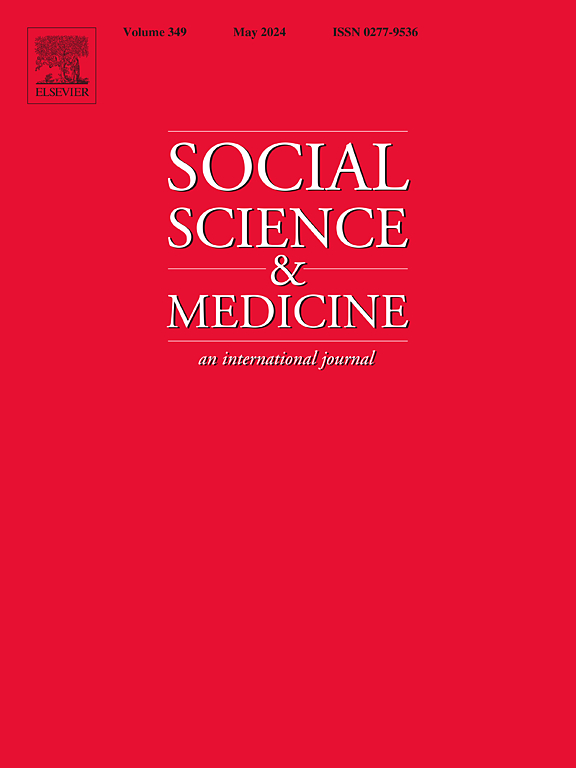The protective power of social connectedness: Individual vs. community influences on psychological distress in middle-aged Black adults
IF 5
2区 医学
Q1 PUBLIC, ENVIRONMENTAL & OCCUPATIONAL HEALTH
引用次数: 0
Abstract
Background
Social connectedness is a crucial determinant of mental health, yet its effects on Black adults remain understudied, particularly in distinguishing between individual and community-level influences. This study examined cross-sectional and longitudinal associations between social connectedness and psychological distress among Black adults at the individual- and neighborhood (census tract) levels.
Methods
Using data from the MIDUS (Midlife in the United States) study, we analyzed 897 Black adults aged 25–74 from an urban setting. Social connectedness was measured across six dimensions: neighborhood social cohesion, social integration, support from family and friends, contribution to the community, and spirituality. After extensive model diagnostics, we employed cluster-robust errors to account for clustering by census tracts. We constructed cross-sectional and longitudinal models using these cluster-robust errors with inverse probability weighting to address attrition, examining individual and census-level effects on psychological distress in immediate and long-term contexts.
Results
In 10-year longitudinal analyses, family support (β = −1.95, 95 % CI = −3.01, −0.90) and friend support (β = −1.09, 95 % CI = −1.66, −0.52) showed significant protective effects against psychological distress. Cross-sectional analyses confirmed protective relationships for neighborhood social cohesion (β = −2.19, 95 % CI = −3.10, −1.28), family support (β = −1.97, 95 % CI = −2.77, −1.16), and friend support (β = −0.74, 95 % CI = −1.40, −0.07). Census-level social connectedness measures were not significantly associated with psychological distress in longitudinal models.
Conclusions
These findings underscore the primacy of individual-level social connections in protecting against psychological distress among Black adults. Mental health interventions should prioritize strengthening personal and family-centered social support networks while incorporating community engagement components for long-term benefits.
社会联系的保护力:个人与社区对中年黑人心理困扰的影响。
背景:社会联系是心理健康的关键决定因素,但其对黑人成年人的影响仍未得到充分研究,特别是在区分个人和社区层面的影响方面。本研究在个人和社区(人口普查区)水平上考察了社会联系和黑人成年人心理困扰之间的横断面和纵向联系。方法:使用MIDUS(美国中年)研究的数据,我们分析了来自城市环境的897名25-74岁的黑人成年人。社会联系通过六个方面来衡量:社区社会凝聚力、社会整合、家庭和朋友的支持、对社区的贡献和精神。经过广泛的模型诊断后,我们采用聚类鲁棒性误差来解释人口普查区的聚类。我们使用这些具有逆概率加权的聚类稳健误差构建了横断面和纵向模型,以解决人员流失问题,并在近期和长期背景下检查个人和人口普查水平对心理困扰的影响。结果:在10年的纵向分析中,家庭支持(β = -1.95, 95% CI = -3.01, -0.90)和朋友支持(β = -1.09, 95% CI = -1.66, -0.52)显示出对心理困扰的显著保护作用。横断面分析证实了邻里社会凝聚力(β = -2.19, 95% CI = -3.10, -1.28)、家庭支持(β = -1.97, 95% CI = -2.77, -1.16)和朋友支持(β = -0.74, 95% CI = -1.40, -0.07)之间的保护关系。在纵向模型中,人口普查水平的社会联系测量与心理困扰没有显著关联。结论:这些发现强调了个人层面的社会关系在防止黑人成年人心理困扰方面的首要作用。精神卫生干预措施应优先加强以个人和家庭为中心的社会支持网络,同时纳入社区参与内容,以获得长期利益。
本文章由计算机程序翻译,如有差异,请以英文原文为准。
求助全文
约1分钟内获得全文
求助全文
来源期刊

Social Science & Medicine
PUBLIC, ENVIRONMENTAL & OCCUPATIONAL HEALTH-
CiteScore
9.10
自引率
5.60%
发文量
762
审稿时长
38 days
期刊介绍:
Social Science & Medicine provides an international and interdisciplinary forum for the dissemination of social science research on health. We publish original research articles (both empirical and theoretical), reviews, position papers and commentaries on health issues, to inform current research, policy and practice in all areas of common interest to social scientists, health practitioners, and policy makers. The journal publishes material relevant to any aspect of health from a wide range of social science disciplines (anthropology, economics, epidemiology, geography, policy, psychology, and sociology), and material relevant to the social sciences from any of the professions concerned with physical and mental health, health care, clinical practice, and health policy and organization. We encourage material which is of general interest to an international readership.
 求助内容:
求助内容: 应助结果提醒方式:
应助结果提醒方式:


